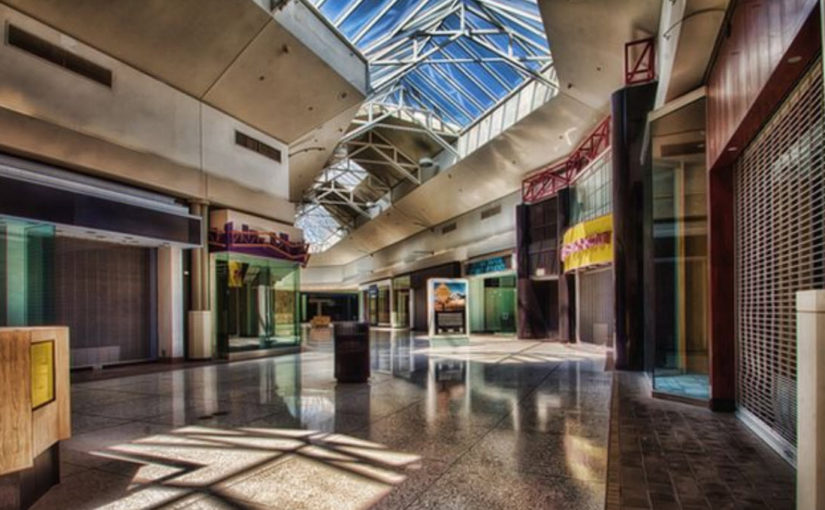Who would have known?
Throughout history, nations rise when there is righteous leadership that cared for its citizens' welfare and do the greater good. When they are corrupt and self-serving, those nations fall. Learn from history because we live in a world governed by cause and effect. History will repeat itself. -Tom Tan
Imagine that. A nation decides to adapt to the people instead of legislating behaviors for them to follow. I know, I know, it’s a long way to go. But to hear that this is happening in the United States is absolutely astounding. It really is.
Wow!
Good stuff!
Great.
It’s about time.
It’s a new world
Yes it is.
I see the global pandemic starting a trend. Actually a series of trends. One of which would be a severely curtailed movement of people across national borders. While others involve a decrease in the use of airlines and planes to go from place to place. You will see these venues downsize.
Just like American malls have down-scaled due to the loss of the American middle class.
the world is changing. you can see it everywhere.
Here’s a scanning robot that I encountered at the mall when I was out getting some groceries. (We go to the mall for fun, we really don’t need to. The delivery services of Er-le-ma and Kangaroo are quite functional.) He said a cheery “Ni Hao!” as I walked by.

.
But you all have got to get the stupid “elected officials” out of Washington DC and start working together to help Americans. All this finger pointing, first to Russia and then to China is just useless and very counter productive. Nothing good will come of it. You have to look inside and address the problems there.
Why is “democracy” so valuable?
It’s heavily promoted (don’t you know) that one-person, one-vote system is the pinnacle of “freedom” and “liberty” in the world. Which is rather strange as the founders of the United States said the absolute opposite.
And people are looking at these various systems of governance with a keen eye. Maybe there needs to be some changes they wonder…
Daniel Bell has put forward his views in favor of China's political meritocracy... against the one person one vote (Western Democracy model) as a mode of selection for political leaders. He has done this in two books. The China Model: Political Meritocracy and the Limits of Democracy Princeton University Press, 2015. ISBN 9781400865505. Dean of the School of Political Science and Public Administration at Shandong University and professor at Tsinghua University (Schwarzman College and Department of Philosophy). He was born in Montreal, educated at McGill and Oxford, has taught in Singapore, Hong Kong and Shanghai, and has held research fellowships at Princeton's University Center for Human Values, Stanford's Center for Advanced Study in the Behavioural Sciences and Hebrew University's Department of Political Science. Here: https://youtu.be/e63ro_suARA
If you are fat and overweight, you change your diet, go to a doctor, exercise more, and monitor your vitals. You do not point at a thin and healthy person and blame them for your problems. Nothing positive or good will come out of it.
Speaking about blaming China…
Pause in WeChat, TikTok ban a positive signal for China-US ties: analysts The Americans were going to ban WeChat and TikTok from the USA. Then they realized many of their businesses - specially the precious petite bourgeois "small businesses" - are only profitable with WeChat, while a whole sector of the "influencers" business only existed (and prospered) because of TikTok (the same way many glorified salesmen only exist in YouTube). My bet is, if they can't outright expropriate WeChat and TikTok (Trump tried to expropriate TikTok, forcing it to include their algorithm and source code in the forced selling of their American branch of the business, essentially creating a second, American clone of the company), the Americans will simply let this legal aberration to slowly die and fade into oblivion. China shows zero tolerance for fake news by banning BBC World News Propaganda is not information. Fake news is not press. Lies are not speech. Therefore, the BBC is not press and is not speech. The USA's response was hilarious. It basically stated that, because China has an oppressive system and the West has a free system (because of reasons), China is not entitled to ban Western news outlets, while the West is entitled to ban Chinese newspapers at will. Typical case of infantile "I'm better than you" rant. Chinese consumption unabated on Spring Festival Eve despite 'stay put' policy After months of double digit cases, Mainland China finally zeroed new cases and is holding its Spring Festival. Meanwhile, the self-governed province of Taiwan cancelled its Spring Festival after eight consecutive months of (officially) zero new cases and just some 20 cases in January (12 of which happened in a cluster, a hospital). Weird, somebody is cooking the books here... UK economy hit by record slump in 2020 but double-dip recession avoided The UK's economy fell double the expected - but at least it avoided a double-dip recession! Why Japan Inc can’t and won’t quit China Welcome to the world of capitalism, Mr. Pesek. -Posted by: vk | Feb 12 2021 12:18 utc | 72
It’s actually pretty bad.
It’s sort of like this…
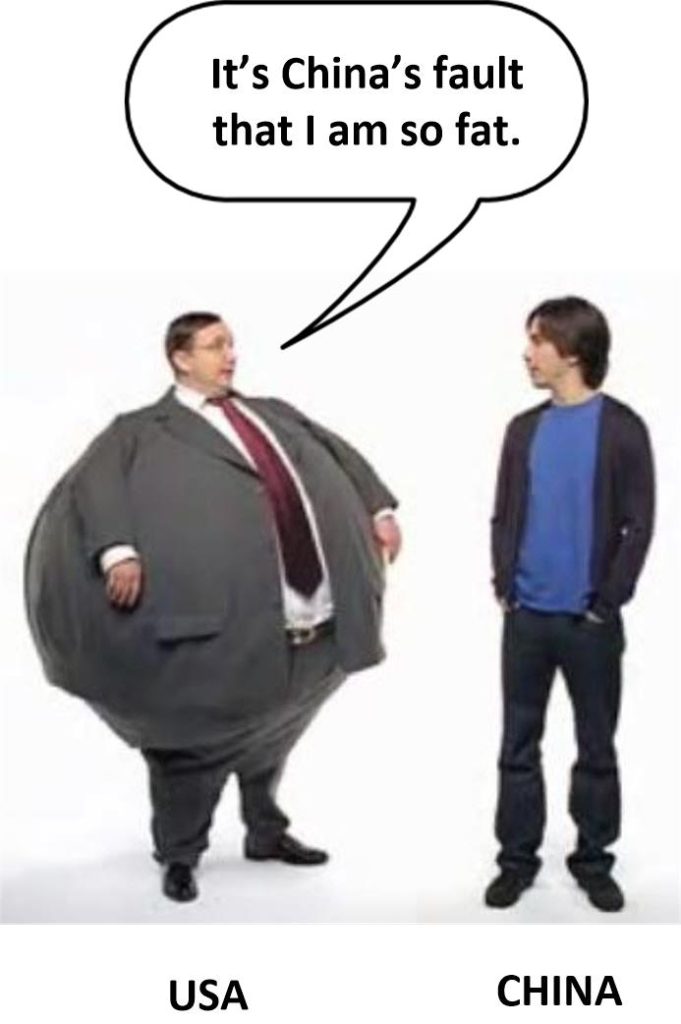
It’s the way of losers.
To blame others for things that you yourself cause. And yet I find it difficult to accept that America is populated with losers. Sure there are evil people in government, and dregs of society shopping at Wal-mart, but certainly decent people still exist, don’t you think?
America is a real mess
Tax freedom day this year fell on Aug. 12. That’s how long it now takes for the middle-class worker to fulfill his “obligation” to the leviathan. The Ponzi scheme that is our fiat money system is insatiable. It inflates away the savings and investments of Main Street America.

.
While the middle-class struggles, the entitlement class grows. High unemployment (who can even count the unemployed at this point), directly caused by government lockdown policies, pushes more people out of the middle class and into the parasite class. One in five American children now lives in poverty, according to a report by the Annie E. Casey Foundation.
But the parasites live well off the producers. They get “free” housing, “free” food, “free” cable television, “free” cell phones. Their kids eat “free” at school (meals are still handed out at schools, even in lockdown). These “entitlements,” along with ever-extended long-term unemployment benefits, become so attractive that the incentive to work is suppressed.
The workers look with disdain on the parasites. The parasites look with envy on the workers, wanting not their jobs but what they have. Recent riots in Great Britain demonstrate what happens when the parasites decide they want more.
Meanwhile, even the working class is at war with one another. This is encouraged by the elites, but the current Administration has doubled down. The thugocracy of the Labor Unions terrorize non-union workers and companies large and small.

In America, everyone is at war with each other. America should be offering a helping hand to others in need. Not trying to fight each other.
.
Tea Party members, at least those who gathered in 2009 and much of 2010 before the Republican Party began to co-opt the movement, were blue collar and white collar, owners of small businesses, retirees, former military, salt-of-the-earth people from all political spectrums who would not support toppling foreign regimes, making war on countries that have not attacked us “for democracy,” or perpetual wars.
And while they indicated they are fed up with the status quo, Tea Party rallies were peaceful and orderly gatherings: Americans engaging in their right to petition government.
Now? Capitol protestors are “terrorists.” Right wing, left wing? Republican, Democrat? Engage in your Two Minutes Hate. The lamestream media talking heads are proud.
The elites love war abroad and at home. It distracts the masses from government’s ongoing theft and manipulation. Anger with one another allows them to continue their looting. It promotes threats and violence, which allows them to further clamp down on freedom.
Endless wars, abroad and at home, equal totalitarianism. It’s totalitarianism under the sweet-sounding name of “democracy“.
.
Lest you think this is not the case, ABC News reports that …
"The Pentagon will deploy more than 1,100 troops to five vaccination centers in what will be the first wave of increased military support for the White House campaign to get more Americans inoculated against COVID-19."
You all think that America isn’t a Oligarchy-run Military Empire?
We need some angels to intervene and set things right.

.
The American cult of the individual denies not just community but the very idea of society. No one owes anything to anyone. All must be prepared to fight for everything: education, shelter, food, medical care. What every prosperous and successful democracy deems to be fundamental rights — universal health care, equal access to quality public education, a social safety net for the weak, elderly, and infirmed — America dismisses as socialist indulgences, as if so many signs of weakness.
How can the rest of the world expect America to lead on global threats — climate change, the extinction crisis, pandemics — when the country no longer has a sense of benign purpose, or collective well-being, even within its own national community? Flag-wrapped patriotism is no substitute for compassion; anger and hostility no match for love. Those who flock to beaches, bars, and political rallies, putting their fellow citizens at risk, are not exercising freedom; they are displaying, as one commentator has noted, the weakness of a people who lack both the stoicism to endure the pandemic and the fortitude to defeat it.
-The Unraveling of America
Anyways…
Let’s get on a more positive note. And let’s start talking about rebuilding America into something better.
The People the Suburbs Were Built for Are Gone
A new book documents the “retrofitting” of obsolete suburban malls, box stores, office parks, parking lots, motels, and more. by Shayla Love written on January 22, 2021, at 1:00am. Edited to fit this venue. All credit to the author.
Last summer, Donald Trump and Ben Carson, then Secretary of Housing and Urban Development, co-bylined an op-ed in the Wall Street Journal promising to “protect America’s suburbs,” describing how they reversed policies that would allow for the creation of denser living structures in areas zoned only for single-family homes.Advertisement
“America’s suburbs are a shining example of the American Dream, where people can live in their own homes, in safe, pleasant neighborhoods,” they wrote.
But the suburbs, in the sense of the idyllic American pastoral Trump and Carson referenced, have been changing for some time—not necessarily the physical homes, stores, roads, and offices that populate them, but the people who live there, along with their needs and desires. Previous mainstays of suburban life are now myths: that the majority of people own their homes; that the suburbs are havens for the middle class; or that the bulk of people are young families who value privacy over urban amenities like communal spaces, walkability, and mixed-use properties.
This mismatch has led to a phenomenon called “suburban retrofitting,” as documented by June Williamson, an associate professor of architecture at the City College of New York, and Ellen Dunham-Jones, a professor of architecture at the Georgia Institute of Technology. They have a new book out this week: Case Studies in Retrofitting Suburbia: Urban Design Strategies for Urgent Challenges.
Welcome to Metropica, a Supposed City of the Future
Allie Conti
Since the 1990s, Williamson and Dunham-Jones have been watching the suburbs evolve. They have found that much of the suburban sprawl of the 20th century was built to serve a very different population than the one that exists now, and so preserving what the suburbs once were doesn’t make sense.
Their book describes 32 recent instances in which suburban structures have been transformed into something new. Many of the cases in Williamson and Dunham-Jones first book from 2011 on the same topic were focused on underused parking lots being transformed into mixed-use spaces. But in this new book, the retrofitting projects have become more ambitious, as cities and towns turn old box stores, malls, motels, or office parks into places for people to live, work, eat, play, exercise, go to the doctor, or even watch Mexican wrestling.Advertisement
They have found that when the suburbs are retrofitted, they can take on an astonishing array of modern issues: car dependency, public health, supporting aging people, helping people compete for jobs, creating water and energy resilience, and helping with social equity and justice.
Motherboard talked with Williamson and Dunham-Jones about why and how we should retrofit the suburbs, and whether or not the COVID-19 has made the suburbs appealing again, or instead accelerated the desire to retrofit the burbs.
The conversation has been edited for length and clarity.
Motherboard: How do you define the suburbs—a slippery term with no concrete definition? You write in the book that you define something as suburban based on its “suburban form," not necessarily on location or city lines—what do you mean by that?
June Williamson: We’re architects and urban designers and so we are focused on the built environment. That means that when we’re looking at places, generally, that have been built out in the second half of the 20th century to be car dependent, not walkable, and have comparatively lower density.
Ellen Dunham-Jones: Similarly, you can look at the street networks. If you’ve got a grid, more or less, with small, walkable-sized blocks, that’s urban form. If you have a highway leading off into cul de sacs, that’s suburban form, which is a more treelike kind of pattern.
JW: That kind of development certainly characterizes most of the peripheral areas around the older urban cores in Northern American cities. But it can also be found within municipal boundaries of cities. We advocate for an erosion of oppositional thinking that you’re either in the city or the suburbs. When you look at a larger metropolitan area, suburban form can also be found near the center in need of retrofitting.
You argue that many of these suburban forms are obsolete today because they don't fit the needs of the people who live there now. Can you walk me through some of the major demographic changes that have led to these suburban forms becoming obsolete?
EDJ: One of the biggest shifts is that the U.S. now is a majority of one to two person households. And yet, the majority of land within regional urban boundaries is zoned for single-family houses. That already is something of a mismatch.
The expectation going forward is that something like 80 percent of new households that will form over the next 15 years will be these one to two person households. A lot of them would prefer an apartment or a condo—smaller units.Advertisement
Plus you have the aging of the society, that’s the other really big piece. Especially in the suburbs, a lot of elderly people loved their single-family house while they were raising the kids. But now that they’re empty nesters and retiring, it’s kind of lonely. They want to stay in their community with doctors and friends nearby. But a lot of them are looking for, frankly, a more urban lifestyle.News
Our Infrastructure Is Being Built for a Climate That’s Already Gone
Shayla Love
It's pretty interesting how the desires of both the younger millennials, Gen Z, and a lot of those aging boomers are converging on an interest in more walkable, mixed-use, compact urban places out in the burbs.
JW: Commuting has also been transformed dramatically over the past decade or so, too. The notion that people live in the suburbs and work in the cities just isn’t true anymore.
EDJ: We tend to think that the jobs are downtown. Since the 1980s, the majority of jobs have been more than three miles from the central business district. In places like Atlanta, where I live, it’s closer to 90 percent of jobs are way outside. The central business district often has high rises and so it’s really visible, but we’re really seeing something called job sprawl. I certainly see in Atlanta, we have a lot of reverse commuters in that situation.
So when you talk about retrofitting, you mean finding and altering underused or abandoned suburban buildings to better accommodate the demographics and desires of the people who live there now?
JW: Absolutely. And in most of the cases we’ve studied, this is happening because the built places have failed or are struggling to some degree. Advertisement
The dead and dying malls, the vacated office parks, the ghost box stores left behind. Rather than bring back the same thing, this is a tremendous opportunity.
It can be as simple as re-inhabiting, or an adaptive reuse—fixing up the building, or changing the parking lot for something that’s better suited to the times. Taking something that was commercial and turning it into housing.
It can also involve re-greening because so much of the suburbanization processes disrupted the regional ecologies and stormwater flow systems. Then it’s an opportunity for wider ranging benefits. There could be places of recreation or social exchange having small plazas and program parks. And then there is redevelopment. Taking a low density, car-dependent use-separated or mono-use place and mixing it up and investing in it.
I was really struck by the statistics in the book about how many parking spaces there are per household in certain cities. Like how there are 1.97 cars per U.S. household, but in Des Moines, Iowa, there are 19 parking spaces per household. In Jackson, Wyoming, there are 27. These all seem like really obvious places to re-think about how we're using land.
JW: These choices around parking we’ve made have been codified through regulations and naturalized as normal.
EDJ: We really have made it almost a right to park as opposed to a right to housing. Cars have much more protection than people do.Advertisement
There are these aging properties for the most part; a lot of them have become obsolete and those are places to retrofit. But sometimes [properties] are thriving. They’re doing well. Yet they still look at their parking lot as this underperforming asphalt. It’s not doing enough of the job. Sometimes there’s a mall that is doing well, and it makes more sense now to build a parking deck and build housing and bring in offices and make more mixed use. Tech
The Broken Algorithm That Poisoned American Transportation
Aaron Gordon
All of these: the parking lots, the dead space, the vacant spaces. Those are the opportunities for the suburbs to finally address really urgent challenges of equity, climate change, and health.
You’ve been documenting retrofitting since 2011, when your first book came out, and now this second book includes even more case studies. Is the retrofitting phenomenon increasing, or does it need a push?
EDJ: If you go into any architecture school or city planning school’s library, there are tons of books on downtowns. There’s remarkably little written about the suburbs or suburbia. Most of what is there are sort of condemning them as wasteful and ecological boring places.
We’re academics, we’re documenting this stuff, but we’re not exactly neutral. We are advocates. We’re advocates within our disciplines to to sort of say, hey, we really need to bring design to the suburbs
There’s so much opportunity. It is where most Americans live. We saw a lot of these projects happening and noticed that none of the architecture magazines would cover them because they weren’t cool looking enough. Advertisement
And yet this stuff was happening. We thought it was important both to say it’s important that the suburbs do retrofit and become more sustainable and resilient in just places. But it’s also really important to recognize this is actually happening. And that this should happen even more. A lot of communities are afraid to do something unless they know that some other community has already done it.

A former Big Lots box store and parking lot converted into the Collinwood Recreation Center in Cleveland, Ohio.
You discuss the many social challenges retrofitting can take on. Some are more obvious like reducing dependency on cars or becoming more environmentally friendly. But there are some less intuitive ways retrofitting can impact our lives, like improving public health.
JW: One of the observations in public health is that there are chronic diseases of our time in developed countries, and certainly in Northern America, related to obesity and the higher incidences of diabetes, and so on.
One way to address those kinds of diseases is simple physical activity, yet we’ve designed physical activity out of our environments. To design it back in is a kind of low cost way of getting people to move their bodies.
A lot of literature looks at how access to nature, being able to have a view of trees, but also being able to socialize with others is really important. That links back to the demographic prevalence of one and two person households. That leads to loneliness. How can our physical environments create places—not force people to be physically active or to socialize in any particular ways—but to support the possibility?Advertisement
Can you explain one specific facet of intentionally designed well-being called the "third place?"
JW: This is a sociological concept. The “first place” is home and then the “second place” is work. The third place is is a little harder to define.
You might know it as the coffee shop, barbershop, or pub—so it might be a privately owned place, a place of business. It’s where one habitually gathers with others, forms friendships, and is engaging in social life. These are the places that we can design into suburbs as a way to support the overall social body.
EDJ: The suburbs largely sold themselves on the value of the terrific private realm that they present. The suburbs emphasize privacy. As these demographics are changing, there’s more and more people recognizing, “I’m lonely. I would like a little bit more of a public realm.”
If your public realm is just a commercial corridor full of strip malls and parking lots, there’s not much opportunity.
What we see happening are both the incorporation of the third places, but also small programmed parks, little town greens that have places for yoga classes, farmers’ markets, concerts, movie nights, and those kinds of activities that don’t force people to talk to one another, but at least enable the building of community.
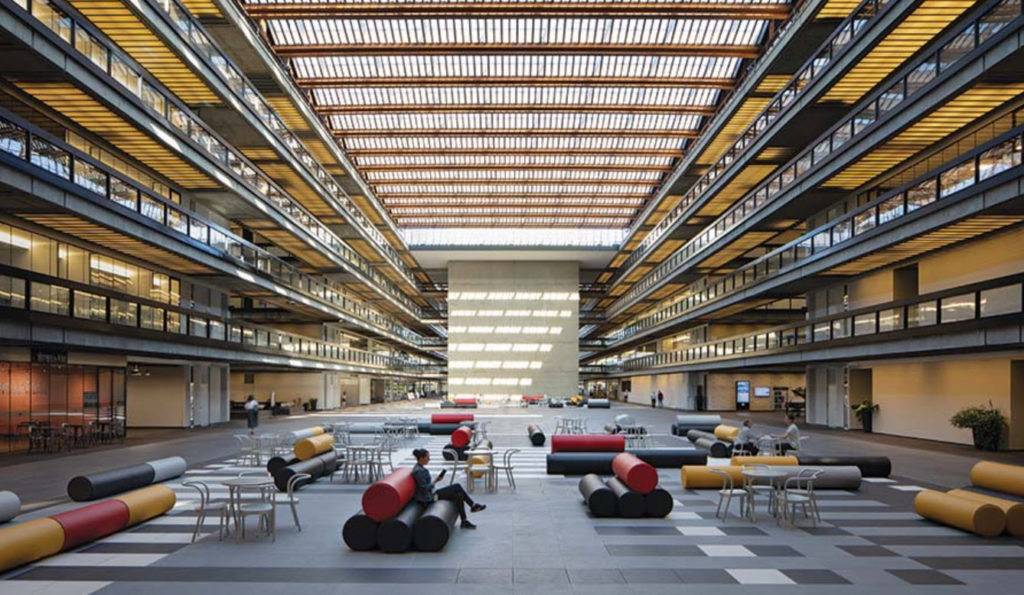
The atrium at Bell Works, formerly Bell Labs in Holmdel, New Jersey.
You also write how retrofitting the suburbs can be a tool for social equity, or minority community building—how does that work?
JW: When thinking about social equity, it’s about how people use their social relationships in their social network in order to get connected to opportunity. It really is worth a lot. And it’s one of the reasons we need to challenge the exclusionary practices that have been codified in suburban jurisdictions for decades now. And the coarse sorting that we find in suburbs.
Some of the ways to break out of that is in older retail properties, the rent might be less. There’s an opportunity for networks of immigrant groups with social and business relationships to form businesses, bring people in, and enliven a place. Advertisement
There is a number of examples of vanilla shopping malls that had seen better days that were dead and dying. They have been reinhabited and revitalized by reflecting the changing demographics of the neighboring areas.
One example is Grand Plaza in Fort Worth, what has been rebranded as a Latino mall. One of the large several story department stores was broken up into hundreds of stalls for very small businesses, like a mercato that you might find in Central America or Mexico. The central atrium space in the mall now hosts Mexican wrestling and other kinds of themed events that reflect the culture of the dominant ethnoburb demographics surrounding it.
These places can also become flash points in political movements. If you’re in the suburbs and you want to gather to have a peaceful protest, where do you go? One of the places you might go is the mall parking lot or along an arterial boulevard.
What is there still left to do when it comes to retrofitting the suburbs with social equity in mind?
EDJ: One of the other myths about suburbia is that the suburbs are middle class. Well, the middle class has been shrinking—we all know that. What we also see is that the suburbanization of poverty has really been tremendous. And yet it’s relatively invisible.
Poverty remains most highly concentrated in our cities. But there’s actually more Americans living in poverty out in the suburbs.Advertisement
We draw attention to some of the efforts that have been made. Sadly, we don’t yet see nearly enough examples of retrofitting that are really addressing the problem.
There have been some cases of aging garden apartments that are the housing of last resort for a lot of very, very poor people.
Those are just kind of aging out. In some cases, they’re being redeveloped into more expensive fancy apartments. We need a lot more attention to preserving and restoring a lot of those. It’s not solving a lot of ecological problems. These places are very auto dependent. But there’s such desperate need for more affordable housing out in the burbs.
JW: I don’t think we can emphasize enough that there are people in very precarious conditions across the metropolitan landscapes of North America, and that retrofitting is a way by increasing the mix and introducing supportive housing and other kinds of support services in places where people aren’t marooned if their car breaks down and so forth. It’s an important factor in this conversation. It’s not something that can be isolated as only a city or urban problem.
Remaking these garden complexes or old motels, if you’re going to add transit, make sure there’s access for lower income people, and also younger people who might be on the beginning stages of their kind of lifelong earning trajectory. They should be saving money and shouldn’t have all of their income poured into housing and supporting a vehicle. 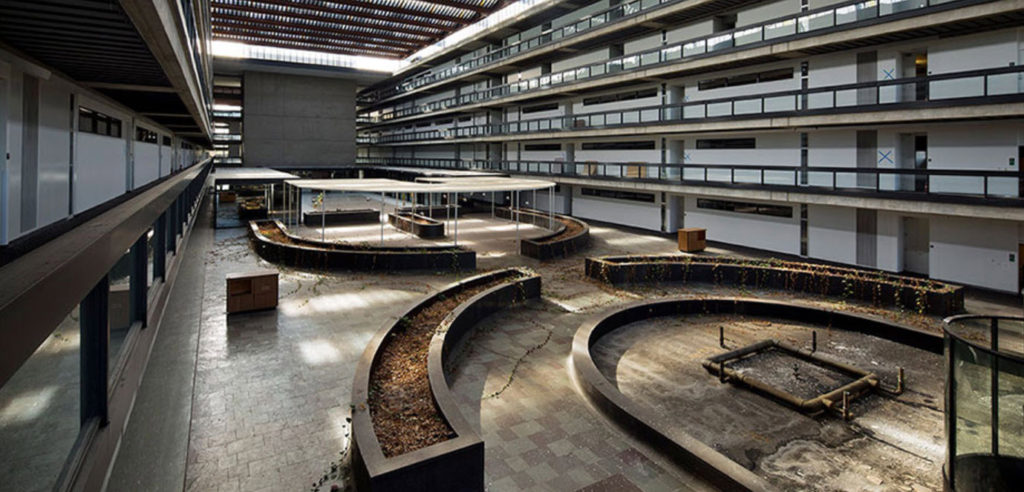
There were a couple other case studies from the book I wanted to bring up. For example, I did not know that Bell Labs had been retrofitted!
JW: That’s a super interesting retrofit. Bell Labs is a storied mid-century modern research and development campus designed by Eero Saarinen, a famous architect who unfortunately died right near its completion.
All sorts of things were invented there: transistors and technologies that led to cell phones. But it lay vacant for many years.
It’s in an affluent exurb in New Jersey, and the municipality hoped to tear it all down and develop 50 or so McMansions there
But the Preservation Society and other groups rallied and a developer got interested, and now it’s become like a vertical downtown. It has a quarter-mile long atrium and dozens of businesses located on the ground floor. They have a farmer’s market, yoga, a hairdresser, a Montessori school, a branch of the local public library, and fireworks on the Fourth of July. It’s called Bell Works.
This kind of development concept is being repeated in another former AT&T property outside Chicago, so we’ll see how that goes.
EDJ: There’s well over 150 office parks that are now being urbanized in some way.
Bell Works is an example of mixing the uses of a space that used to be just offices, and where the assumption was that scientists would have epiphanies if they were isolated in their office looking at a pastoral landscape. Now, we tend to think of innovation as occurring in much more urban places, and it’s the chance encounters that trigger innovation.
It’s also being driven because employers recognize that the younger workers do not want to work in a cubicle in an office park. They do not want to work in a place that is only “work.”Advertisement
Another great example is the old box store that became a recreation center.
JW: Yes,in this case it was Big Lots in a relatively low-income neighborhood on the periphery of Cleveland that has been transformed into a recreational center.
It now has a running track through it, a pool, some outdoor recreational spaces, and it’s yards from the lake there, too.
There are opportunities to take these dead retail boxes all across the country—and there are thousands of them—and rethink not only the building itself, but the entire property and parking lots to support health, wellness, day care clinics, clinics for routine health care, libraries, and other kinds of sharing services.
Sometimes it's not about redeveloping these spaces, but about regreening them. Can you give an example of that kind of project?
JW: Back in the 19th century, Meriden, Connecticut lost all of its industrial use and job space, and so by the middle of the 20th century, a suburban, enclosed shopping mall had been built in the middle of downtown over in creek, and it failed miserably.
Every time there was a big storm event, the creek would flood and cause millions of dollars of damage to all the neighboring businesses and the town had become increasingly lower-income.
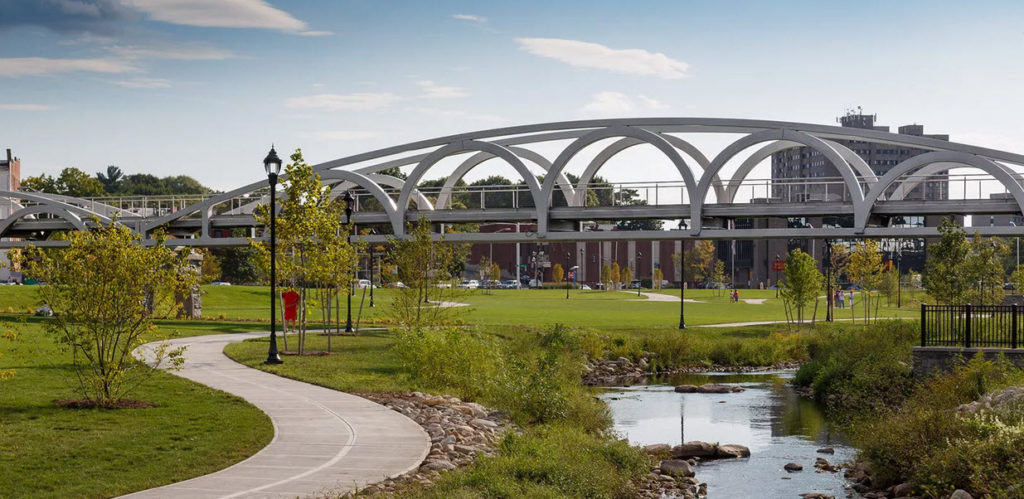
Formerly a mall and parking lot, Meriden Green, CT, now has relocated subsidized housing, and green infrastructure including a daylit brook and stormwater park.
What happened here was an incredible greening retrofit where the mall was demolished, the creek that had been put into concrete below ground was opened back up to the air. The ground was regraded—that’s a technical term, but basically the surface of the ground was made lower.
The whole property was turned into a park, which is a stormwater park. The next time there’s a big storm event, the park becomes like a big bathtub and water will drain there and eventually percolate into the soil and not cause all of the damages that it had in previous cycles.
There’s this beautiful amenity and then around it, lots of new housing is being built that then has the park amenity. There’s a train station right there that’s been rebuilt with increased service through central Connecticut. It has all of these kinds of connected benefits around taking away development.
Last summer, the New York Times wrote that "New Yorkers Are Fleeing to the Suburbs" because of the pandemic. There's been this narrative that people who live in urban areas are moving back to the suburbs—and they suddenly want the things that were previously obsolete. Do you think that's true, and would it put a stall on these kinds of retrofitting projects?
JW: Broadly, what we’ve seen in this past year is an intensification, or an acceleration, of some of the trends that were happening already. There was already the redistributing of populations to some of those locations, especially in metro areas like New York, which are so insanely expensive. If you could find something that was New York-like in New Jersey or Westchester or Long Island, it would make sense that those places might be attractive to people.
What we’re seeing right now, I think in New York certainly, is people who’d been thinking about this acting on it. But where are they moving in the suburbs? They’re not rejecting the urban lifestyle altogether. They’re being drawn to already urbanizing locations in the suburbs.
It’s not a complete rejection of one for the other, but it’s finding like for like. Still, the evidence is mostly anecdotal at this point. Time will tell.
I think it’s also understood that developers who are planning new projects in these suburban locations are looking to make mixed-use places, and are looking to add different housing types in their suburban projects.
EDJ: In the long run a lot of those suburbs that those folks are moving to, if they’re going to retain those households, they’re going to have to start providing more of the urban amenities.
I’m certainly seeing around Atlanta as one example, a lot more communities changing their zoning to allow for access to accessory dwelling units, to allow for what’s been called the “missing middle”—duplexes, quadplexes, townhouses—in existing neighborhoods with suburban neighborhoods that were single family [only]. Now they’re allowing that densification.
Those regulatory changes have happened just in the last eight months. There’s been a surge of that. And it’s very much in response to recognizing that there is the market, the demand. People want these more urban lifestyles, even if they are choosing to move to the burbs. A lot of people who have isolated themselves might still be craving places to be able to gather safely. And so it could accelerate the retrofitting of suburbia.
America is a real mess.
But it’s changing.
It is a constructed gulag for Americans and you all had best not get “out of line”. You must obey or suffer the consequences. I am reminded about how the jails and prisons are in Communist China. Did you know that they have been modeled after the Arkansas (American state) Hard-Labor Camps? Yeah, it was a surprise to me too. But when I was in the ADC, sure enough, there was a delegation from China there at Pine Bluff, and Brickey’s learning about how best to construct workable hard-labor camps.
You can see that they have taken a page from the American police state and improved upon it…
.
Now, the Arkansas hard-labor system was modeled by Nazi German immigrants after World War II who took former slave plantations such as Brickey’s North Arkansas Regional Unit and turned them into hard-labor camps. Which is why they greatly resemble the old “resettlement” camps that the Nazi’s constructed in Poland during World War II. Anyways, the Chinese see the efficiency of this system and have incorporated elements in their own prison system.
So yes, America is a model for the world!
Chinese Jail and Prison.
America is changing
Yes, it is.
After the crisis event during a fourth turning, the resulting America will be substantially changed afterwards. We can see that the changes are starting. And they are long over due. We do not know the full extent of the changes, but we do need to be aware that they are in process.
Forget your fantasies that America will relive the American Civil War, the American Reconstruction Period, or the growth of suburbia in the 1950’s and 1960’s. The resulting American will be quite different, and will NOT resemble any other nation on the globe. It will be a uniquely American change. Let’s pray and hope that it will be a good one
In the meantime, please keep your eyes open. Look for examples of change. That will provide you with insight on the future of America. It is your “weather vane” to judge the direction that America is heading towards. Keep in mind that the “news” is really a horrible medium to view changes. You need to take “deep dives” into other sources, and use your own eyes and ears to provide you guidance.
Fauci, Biden's top medical adviser, told CNN that the approaching deaths tally (of 500,000) was "a terribly historic milestone in the history of this country."
-Reuters
Evidence of the changes are all around us.
Do you want more?
I have more posts along these lines in my Functional Notes Index.
Articles & Links
You’ll not find any big banners or popups here talking about cookies and privacy notices. There are no ads on this site (aside from the hosting ads – a necessary evil). Functionally and fundamentally, I just don’t make money off of this blog. It is NOT monetized. Finally, I don’t track you because I just don’t care to. To go to the MAIN Index;
Master Index
- You can start reading the articles by going HERE.
- You can visit the Index Page HERE to explore by article subject.
- You can also ask the author some questions. You can go HERE .
- You can find out more about the author HERE.
- If you have concerns or complaints, you can go HERE.
- If you want to make a donation, you can go HERE.
Please kindly help me out in this effort. There is a lot of effort that goes into this disclosure. I could use all the financial support that anyone could provide. Thank you very much.

